Your kitchen sink and dishwasher work hard every day, but when was the last time you gave them a deep clean? Keeping these two essentials spotless not only makes your kitchen look great but also prevents bad smells, germs, and buildup that can slow them down.
If you want to make sure your sink and dishwasher stay fresh, hygienic, and running smoothly, you’re in the right place. Keep reading, and you’ll discover simple, effective ways to clean both quickly—saving you time and effort while boosting your kitchen’s cleanliness.

Credit: www.maytag.com
Preparing Your Cleaning Supplies
Preparing your cleaning supplies is the first step to a spotless kitchen sink and dishwasher. Having the right tools makes the job easier and faster. It also ensures you clean thoroughly without damaging surfaces.
Gather everything before you start. This saves time and avoids interruptions. Organize your supplies so you can reach them easily during cleaning.
Essential Tools For Sink Cleaning
- Soft scrub brush or sponge
- Baking soda for gentle scrubbing
- White vinegar as a natural cleaner
- Dish soap for grease removal
- Old toothbrush for tight spots
- Microfiber cloth for drying and polishing
- Rubber gloves to protect your hands
Gathering Dishwasher Cleaning Materials
- Dishwasher cleaner or white vinegar
- Baking soda for deodorizing
- Soft cloth or sponge
- Toothpick or small brush for spray arms
- Warm water for rinsing
- Rubber gloves for protection

Credit: www.aol.com
Cleaning The Kitchen Sink
Keeping the kitchen sink clean is essential for a healthy kitchen. It prevents germs and keeps your space fresh. Regular cleaning also stops stains and bad smells. A clean sink looks nice and helps with daily chores.
Removing Debris And Food Particles
Start by clearing any leftover food or debris. Use a paper towel or cloth to wipe out crumbs. Run hot water to wash away small bits. Check the drain for trapped particles and remove them carefully. This step stops clogs and keeps water flowing well.
Scrubbing With Natural Cleaners
Natural cleaners work well and are safe for your sink. Mix baking soda with a little water to make a paste. Spread the paste over the sink surface. Use a soft sponge to scrub gently in circles. Rinse with warm water to remove all residue. This method cleans without harsh chemicals.
Tackling Stains And Hard Water Spots
Hard water spots can make your sink look dull. Use white vinegar to remove these stains. Soak a cloth in vinegar and place it on the spots. Leave it for 10-15 minutes. Scrub gently with a soft brush or sponge. Rinse well to see a shiny, clean sink.
Deodorizing The Sink Drain
Bad smells often come from the drain. Pour half a cup of baking soda into the drain first. Follow with one cup of white vinegar. Let the mixture fizz and work for 10 minutes. Flush the drain with boiling water. This clears odors and keeps the drain fresh.
Maintaining The Faucet And Fixtures
Maintaining the faucet and fixtures is key to a clean kitchen sink and dishwasher area. Clean fixtures look shiny and new. They also work better without clogs or leaks. Regular care stops damage and keeps water flowing well.
Removing Mineral Buildup
Mineral buildup forms from hard water. It appears as white or green crusts on faucets. To remove it, soak a cloth in vinegar. Wrap the cloth around the affected area. Let it sit for 30 minutes to an hour. Then, scrub gently with a soft brush or sponge. Rinse with warm water and dry with a cloth. Repeat if needed to clear tough spots.
Polishing And Sanitizing
Polishing fixtures keeps them bright and smooth. Use a non-abrasive cleaner or a mix of baking soda and water. Apply with a soft cloth in circular motions. Rinse well to remove all cleaner. Dry with a microfiber cloth to avoid water spots. For sanitizing, use a mild disinfectant spray. Wipe all surfaces, focusing on handles and spouts. This reduces germs and keeps your kitchen healthy.
Cleaning The Dishwasher Interior
Cleaning the dishwasher interior removes food buildup and odors for better performance. Run a hot cycle with vinegar or a dishwasher cleaner to keep it fresh. Wipe seals and corners to prevent mold and grime.
Cleaning the dishwasher interior is essential for its efficiency. Dirt and grime can build up over time. This affects the machine’s performance and cleanliness. Regular cleaning prevents problems and ensures your dishes come out sparkling.
Emptying And Inspecting The Dishwasher
Start by emptying the dishwasher completely. Remove all dishes and utensils. Check for any visible debris or food particles. Look at the spray arms and racks. Ensure they are free of blockages. Check the door seals for any grime or mold. This ensures everything runs smoothly.
Removing And Cleaning Filters
Locate the dishwasher filters. They are usually at the bottom of the machine. Remove them carefully. Rinse under warm water to remove food particles. Use a soft brush if needed. This helps maintain water flow and cleaning efficiency.
Running A Cleaning Cycle With Vinegar Or Detergent
Place a cup of white vinegar on the top rack. Run a hot water cycle. This cleans and deodorizes your dishwasher. Alternatively, use a dishwasher-safe detergent. Follow the manufacturer’s instructions. This removes residue and freshens your machine.
Dealing With Mold And Mildew
Mold and mildew can develop in damp areas. Use a mixture of vinegar and water. Wipe down the interior surfaces. Pay attention to the door seals and edges. This helps prevent mold growth. Ensure the dishwasher is dry after each use. Leave the door slightly open if possible.
Cleaning Dishwasher Exterior
Cleaning the exterior of your dishwasher is just as important as maintaining its interior. A spotless outside not only keeps your kitchen looking fresh but also helps your appliance last longer. Let’s focus on two key areas: the control panels and stainless steel surfaces.
Wiping Down Control Panels
Your dishwasher’s control panel is the command center, so it deserves gentle care. Use a soft, damp cloth to wipe away fingerprints and food splatters without pressing too hard. Avoid harsh chemicals that might damage the buttons or screen.
If you notice stubborn spots, try a mild soap solution, but make sure to dry the panel thoroughly afterward. Have you ever ignored cleaning this area only to find sticky residue ruining the touch sensitivity? Keeping it clean ensures smooth operation every time.
Polishing Stainless Steel Surfaces
Stainless steel gives your dishwasher a sleek look, but it can show smudges and streaks easily. Grab a microfiber cloth and a small amount of stainless steel cleaner or even a few drops of olive oil to buff the surface.
Wipe in the direction of the grain to avoid scratches and enhance shine. This simple step transforms your dishwasher from dull to dazzling and can become a quick part of your kitchen cleaning routine. How often do you stop to appreciate the gleam of your appliances?
Preventive Tips For Long-lasting Cleanliness
Keeping your kitchen sink and dishwasher clean is easier with simple preventive steps. These tips help avoid buildup and bad smells. Following regular care routines saves time and keeps appliances fresh longer.
Regular Maintenance Routines
Clean the sink daily by rinsing with warm water. Use a mild soap and soft sponge to wipe surfaces. Clear food scraps from the drain to prevent clogs.
Run the dishwasher empty once a week using a dishwasher cleaner or vinegar. Check and clean the filter regularly to remove trapped debris. Wipe the door seals to stop mold and grime buildup.
Avoiding Common Mistakes
Do not pour grease or oil down the sink drain. These substances harden and block pipes. Avoid overloading the dishwasher; it reduces cleaning efficiency and stresses parts.
Skip harsh chemicals that can damage finishes or seals. Use gentle cleaners designed for kitchen appliances. Always use the recommended detergent and rinse aid to keep the dishwasher working well.

Credit: www.bosch-home.com.sg
Frequently Asked Questions
How Often Should I Clean My Kitchen Sink?
Clean your kitchen sink daily to remove food debris and bacteria. Deep clean weekly using baking soda and vinegar. Regular cleaning prevents stains, odors, and keeps your sink hygienic and fresh.
What Is The Best Way To Clean A Dishwasher?
Run an empty cycle with white vinegar monthly to remove buildup. Clean the filter regularly and wipe door seals. This keeps your dishwasher efficient and free from odors.
Can I Use Bleach To Clean My Kitchen Sink?
Yes, but use diluted bleach carefully to avoid damage. Rinse thoroughly after application. Bleach kills germs but may harm some sink materials, so test on a small area first.
How Do I Remove Odors From My Kitchen Sink?
Use baking soda and lemon juice to neutralize odors. Pour a mixture down the drain, let it sit 10 minutes, then rinse with hot water. This effectively removes unpleasant smells.
Conclusion
Cleaning your kitchen sink and dishwasher keeps your kitchen fresh and safe. Regular cleaning stops germs and bad smells. Use simple tools and natural cleaners for the best results. Small daily habits make a big difference over time. Keep your kitchen shining with easy, regular care.
Clean sinks and dishwashers help food taste better too. Stay consistent, and enjoy a cleaner, healthier kitchen every day.




